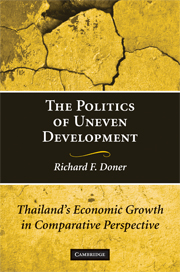Book contents
- Frontmatter
- Contents
- List of Tables and Figures
- Acknowledgments
- List of Abbreviations
- 1 The Challenge of Uneven Development
- 2 Puzzles of Thai Development in Comparative Perspective
- 3 Development Tasks, Institutions, and Politics
- 4 Origins and Consequences of Thailand's Intermediate State
- 5 Sugar
- 6 Textiles
- 7 Automobiles
- 8 Conclusion
- Appendix
- Bibliography
- Index
4 - Origins and Consequences of Thailand's Intermediate State
Published online by Cambridge University Press: 05 June 2012
- Frontmatter
- Contents
- List of Tables and Figures
- Acknowledgments
- List of Abbreviations
- 1 The Challenge of Uneven Development
- 2 Puzzles of Thai Development in Comparative Perspective
- 3 Development Tasks, Institutions, and Politics
- 4 Origins and Consequences of Thailand's Intermediate State
- 5 Sugar
- 6 Textiles
- 7 Automobiles
- 8 Conclusion
- Appendix
- Bibliography
- Index
Summary
The creation of the modern Thai state in the mid-to-late nineteenth century prompted predictions that Thailand's economic growth would rival that of Japan's newly established Meiji state. Instead, Thailand emerged from World War II and moved into the late 1950s as a preindustrial economy with a healthy but relatively undifferentiated agricultural sector. Beginning in the early 1960s, however, the economy took off. Agriculture began to diversify, and new industrial activities attracted investment. By the 1990s, dynamic growth and diversification had made Thailand an “East Asian Miracle.” Yet apprehension about the shallowness of the country's industrialization grew as diversified export dynamism was matched by rising import dependence and competition from other low-wage producers. The 1997 Asian economic crisis made it clear that these concerns were justified. Upgrading became a central focus of the country's recovery efforts. But almost a decade after the crisis, the World Bank warned that Thai growth could not be sustained unless the country's technological base was improved.
The present chapter traces the institutions and politics of this evolution in order to provide both background for the subsequent sectoral analyses and an initial assessment of the book's framework. The chapter is organized into six time periods, each of which is distinguished by shifts in reform pressures and political competition. The analysis of each period begins with a demand-side focus on key policy tasks and institutional responses.
- Type
- Chapter
- Information
- The Politics of Uneven DevelopmentThailand's Economic Growth in Comparative Perspective, pp. 95 - 140Publisher: Cambridge University PressPrint publication year: 2009



